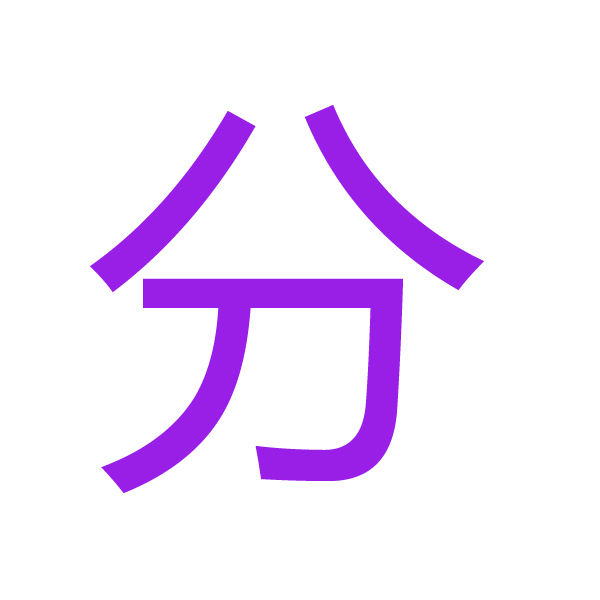
The Kanji: 分 (Wakar.u / Bun) - The "Divide" and "Understand" Kanji
The kanji 分 is a deeply conceptual character that represents the ideas of division, parts, understanding, and minutes. Its meaning beautifully connects the concrete act of splitting with the abstract act of comprehension.
1. Meaning and Usage
Core Meanings: To divide; to separate; a part; to understand; minute (unit of time).
Readings:
Kun'yomi (Japanese reading): わ.ける (wakeru), わ.かる (wakaru), わ.かれる (wakareru)
On'yomi (Chinese reading): ブン (bun), フン (fun), ブ (bu)
Common Words and Compounds:
分かる (わかる / wakaru) - To understand; to comprehend. (The core idea is that understanding is "dividing" or "separating" concepts in your mind).
分ける (わける / wakeru) - To divide; to separate; to share.
三分 (さんぷん / sanpun) - Three minutes.
自分 (じぶん / jibun) - Oneself (Literally "self-part").
十分 (じゅうぶん / jūbun) - Enough; sufficient (Literally "ten parts").
2. Writing and Stroke Order: The Blade of Division
The correct kanji writing for "分" introduces a common structural pattern: a top-heavy component over a blade.
Stroke Order:
Stroke 1: A short left-falling stroke from top to bottom.
Stroke 2: A short right-falling stroke that crosses the first stroke, forming the "eight" (八) shape at the top. This represents the idea of something splitting apart.
Stroke 3: A horizontal折 (or) stroke. Start with a short horizontal line, then turn sharply downward into a hook. This begins the "blade" component.
Stroke 4: A final left-falling stroke (a slash) that starts from the center and sweeps down to the left. This is the cutting edge of the blade.
Significance of Correct Kanji Writing:
Balance and Proportion: The top "八" component should be wide enough to comfortably cover the "刀" below. The bottom blade should not extend wider than the top.
The "Knife" Radical: The lower part of this kanji is 刀 (katana), the "knife" or "blade" radical. Its presence directly conveys the meaning of "to cut" or "to divide."
Efficiency: This stroke order is the most efficient and natural way to form the character, ensuring a balanced and correct shape every time.
3. Historical Origin and Evolution
The history of "分" is a literal and logical representation of its meaning.
Oracle Bone Script (甲骨文字):
The original character was a clear ideogram. It depicted a knife (刀) dividing an object into two parts. The object being divided was often represented by a line or a simple shape, and the knife was shown clearly cutting through it.
Bronze Script (金文) & Seal Script (篆書):
The form became more stylized and regular. The "object" being divided evolved into the 八 shape at the top, which is itself a character that means "eight" but originally meant "to divide." The knife (刀) below remained clearly recognizable.
Modern Form (楷書):
The modern "分" is a clean abstraction of its ancient form. The top 八 continues to symbolize the act of splitting or the resulting parts. The bottom 刀 has been stylized but is still clearly the "knife" radical, providing the means for the division.
Philosophical and Conceptual Connection:
The genius of this kanji lies in how it connects physical and mental acts. Just as a knife divides a physical object, the intellect "divides" a complex problem into understandable parts. This is why 分かる (to understand) is the most common verb using this kanji—understanding something is mentally "breaking it apart" to comprehend its components. Similarly, a 分 (minute) is a "division" of an hour.
Summary
The kanji 分 is a masterclass in logical character design. It visually and conceptually links the physical tool of division (the knife) with the abstract results (parts, understanding, time). Mastering its stroke order is a key step in Japanese kanji writing, as it teaches how to balance a top-heavy structure with a sharp, lower component. When you learn how to write kanji like "分," you are learning more than a symbol; you are learning a fundamental way of thinking about the world, where to comprehend something is to see its constituent parts clearly.